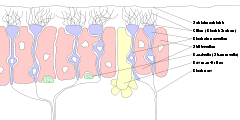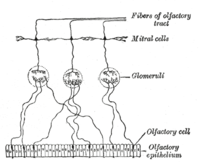- Olfactory receptor neuron
-
Neuron: Olfactory receptor neuron 
Labels in German. "Zellen" = "cell","riech" = "smell", "Riechnerv" = olfactory nerve, "cillien" = cilia.Location olfactory epithelium in the nose Function Detect traces of chemicals in inhaled air (sense of smell) Neurotransmitter Glutamate Morphology Bipolar sensory receptor Presynaptic connections None Postsynaptic connections Olfactory bulb Gray's subject #223 996 NeuroLex ID nifext_116 Code TH H3.11.07.0.01003 An olfactory receptor neuron (ORN), also called an olfactory sensory neuron (OSN), is a transduction cell within the olfactory system.[1]
Contents
Vertebrates
Humans have about 40 million olfactory receptors that detect up to 10,000 different odors. In vertebrates, ORNs are bipolar neurons with dendrites facing the interior space of the nasal cavity and an axon that passes through the cribiform plate then travels along the olfactory nerve to the olfactory bulb. The ORNs are located in the olfactory epithelium in the nasal cavity. The cell bodies of the ORNs are distributed among all three of the stratified layers of the olfactory epithelium.[2]
Structure
Many tiny hair-like cilia protrude from the olfactory receptor cell's dendrite into the mucus covering the surface of the olfactory epithelium. The surface of these cilia is covered with olfactory receptors, a type of G protein-coupled receptor. Each olfactory receptor cell expresses only one type of olfactory receptor (OR), but many separate olfactory receptor cells express ORs which bind the same set of odors. The axons of olfactory receptor cells which express the same OR converge to form glomeruli in the olfactory bulb.
Function
ORs, which are located on the membranes of the cilia have been classified as a complex type of ligand-gated metabotropic channels.[3] There are approximately 1000 different genes that code for the ORs, making them the largest gene family. An odorant will dissolve into the mucus of the olfactory epithelium and then bind to an OR. ORs can bind to a variety of odor molecules, with varying affinities. The difference in affinities causes differences in activation patterns resulting in unique odorant profiles.[4] [5] The activated OR in turn activates the intracellular G-protein, GOLF (GNAL), adenylate cyclase and production of cyclic AMP (cAMP) opens ion channels in the cell membrane, resulting in an influx of sodium and calcium ions into the cell, and an efflux of chloride ions. This influx of positive ions and efflux of negative ions causes the neuron to depolarize, generating an action potential.
Insects
In insects, olfactory receptor neurons typically reside on the antenna. Much like in vertebrates, axons from the sensory neurons converge into glomeruli in the antennal lobe.
References
- ^ J. Rospars, (1998) Dendritic integration in olfactory sensory neurons: a steady-state analysis of how the neuron structure and neuron environment influence the coding of odor intensity. J Comput Neurosci. 5: 243-266. PMID 9663551
- ^ A. Cunningham, P. Manis, P. Reed, G. Ronnett, (1999) Olfactory receptor neurons exist as distinct subclasses of immature and mature cells in primary culture. Neuroscience 93(4): 1301-1312. PMID 10501454
- ^ K. Touhara, (2009) Insect olfactory receptor complex functions as a ligand-gated ionotropic channel 1170 International Symposium on Olfaction and Taste: Ann. N.Y. Acad. Sci. 177-180 PMID 19686133
- ^ S. Bieri, K. Monastyrskaia, B. Schilling, (2004) Olfactory receptor neuron profiling using sandalwood odorants. Chem. Senses 29:483-487 PMID 15269120
- ^ J. Fan and J. Ngai, (2001) Onset of odorant receptor gene expression during olfactory sensory neuron regeneration. Dev Biol. 229: 119-127 PMID 11133158
See also
External links
- olfactory+receptor+cells at eMedicine Dictionary
- NIF Search - Olfactory receptor neuron via the Neuroscience Information Framework
Sensory system: Olfactory system / Olfaction / Rhinencephalon (TA 15.1, GA 10.992) Olfactory epithelium Olfactory nerve: 1° neuron Olfactory nerve: 2° neuron Lateral olfactory stria/
Primary olfactory cortexPiriform cortex · EC-hippocampus system (Entorhinal cortex, Hippocampal formation) · Prepyriform area · Periamygdaloid cortex
Stria medullaris → Habenular nuclei
Amygdala → Stria terminalis → Hypothalamus
Medial forebrain bundle → HypothalamusMedial olfactory stria Categories:- Chemoreceptor cells
- Olfactory system
- Neurons
- Signal transduction
Wikimedia Foundation. 2010.

